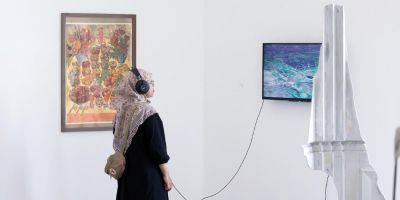Leeds PhD student co-curates a new exhibition exploring 19th century Europe’s fascination with the Far East
Leeds PhD student co-curates a new exhibition exploring 19th century Europe’s fascination with the Far East
A new display of fine and decorative arts on loan from The Bowes Museum collection, co-curated by two PhD students from the universities of Leeds and Durham, opened on Saturday 2 September at The Garden Rooms at Tennants in Leyburn.
The exhibition — John and Joséphine Bowes: Collecting the Far East — explores nineteenth-century Europe’s fascination with the Far East through the collection of The Bowes Museum, Barnard Castle.
The display has been researched and assembled by Simon Spier (School of Fine Art, History of Art and Cultural Studies, University of Leeds) and Lindsay Macnaughton (Durham University) — both doctoral students funded by the Arts and Humanities Research Council (AHRC) through the National Gallery’s Collaborative Doctoral Consortium in partnership with The Bowes Museum.
A figurine in hard-paste porcelain of a seated tiger, c.1700 in Japanese Kakiemon-style ware, Bowes Museum No X.6102The Bowes Museum’s founders, John (1811-1885) and Joséphine Bowes (1825-1874), collected a significant amount of fine and decorative art that represents non-Western cultures. This exhibition provides the opportunity to highlight some pieces not normally on prominent display, and to investigate them in greater detail.
Exquisite examples of furniture, ceramics, textiles, painting and curiosities, mainly from China and Japan, have been selected to illustrate some of the ways in which wealthy Europeans collectors were able to engage with foreign cultures.
John and Joséphine Bowes sought out samples of non-Western techniques, foreign materials and fine craftsmanship that were adapted or emulated by European artists and makers. They also collected objects that represented the customs and cultures that fascinated them. Their attraction to depictions of the Far East exemplified the trend for exoticism that swept over Europe in the nineteenth century, alongside the revival of the Rococo, which was equally fashionable.
Antoine Dury (1819-after 1878), Portrait of Joséphine Bowes (1825-1874), signed and dated 1850. © The Bowes MuseumThe exhibition also investigates the wider influences of the East on Europe. In particular, it describes the influx of exotic objects into the auction houses and the grand International Exhibitions of the middle decades of the nineteenth century.
Simon Spier is s PhD student based within the Centre for the Study of the Art and Antiques Market at the University of Leeds, currently undertaking research into ‘Creating the Bowes Museum: Private collecting, public philanthropy and the art market in the public art museum in Britain and France, 1830-1900’. He said of the exhibition:
“This display neatly overlaps Lindsay’s interests in the Bowes’ engagement with history through material culture with my own in the Bowes’ relationship to the art market, as well as opening up a new area of research — their fascination with non-European world cultures — through primary research in the museum’s archive. It also created the fantastic opportunity to do some close reading of objects that are not normally on display in the museum and put them into a new context with more familiar pieces.
“The staff at The Bowes Museum have been endlessly supportive of the project and I feel I have learnt so many useful and practical skills throughout the process.”
Jane Whittaker, Head of Collections at The Bowes Museum, said:
Jacques Eugene Feyen (1815-1908), Portrait of John Bowes (1811-1885), signed and dated 1863. © The Bowes Museum“For the third consecutive year, The Bowes Museum was invited to curate a small display in Tennants Garden Rooms. This provided an ideal opportunity for Simon and Lindsay at the end of their first year as Collaborative Doctoral Partnership students at the Museum.
“Working with the Curator of Decorative Arts, Dr Howard Coutts, and with support from the Museum’s conservation team, they have researched and brought together a fascinating group of items collected by the Bowes’ Founders, including material and books from the archive and library. The result is an eye-catching display of visual and intellectual appeal.
“From the largest item (a magnificent 19th century Japanese Palanquin decorated with gold on a black lacquer background with engraved gilt-metal mounts, purchased by John Bowes in April 1872) to one of the smallest (an exquisite late 18th/early 19th century jade and amber snuff bottle), each piece has been chosen to represent the Founders’ taste and interest and with a story to match the amazing narrative of The Bowes Museum and its collections.
“I am sure Simon and Lindsay have gained far more than wider knowledge of the collections and that the project has introduced them to some of the wider curatorial considerations of curating a display and negotiating with various staff across two organisations.”




